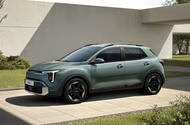What’s New with the 2026 Kia Stonic and Why Are People Talking About It?
If you’ve been keeping an eye on the compact crossover scene, you’ve probably noticed the buzz around the 2026 Kia Stonic. This isn’t just a minor facelift—it’s a significant refresh that brings the Stonic up to speed with the latest design trends and tech, while still holding onto the things that made it popular in the first place. So, what’s changed, and why does it matter? Let’s break it down.
How Does the 2026 Kia Stonic Stand Out in a Crowded Market?
The small SUV market is fiercely competitive, with heavyweights like the Ford Puma and Nissan Juke setting the pace. Kia’s answer? A bold new look that’s hard to ignore. The 2026 Stonic adopts the brand’s ‘Opposites United’ design philosophy, which you’ll recognize from models like the EV3. The result is a sharper, more modern front end that gives the Stonic a confident, upmarket presence.
But it’s not just about looks. Kia’s decision to keep the Stonic’s dimensions largely unchanged—4165mm long, 1760mm wide, with a 352-litre boot—means it remains practical for city driving and weekend getaways alike. It’s the kind of car that fits your life, not the other way around.
What’s Under the Hood? Powertrain Choices Explained
One of the biggest questions buyers have is about what’s powering the new Stonic. Kia is sticking with its tried-and-true 1.0-litre three-cylinder turbo petrol engine, but with a twist. In Korea, you’ll get two options: a standard petrol version offering 99bhp and 127lb ft of torque, and a mild-hybrid version that bumps power up to 113bhp (with the same torque).
What does that mean in real-world terms? The standard engine gets you from 0-62mph in 11 seconds, while the mild hybrid shaves a bit off that time, coming in at 10.7 seconds. CO2 emissions are also improved, with the mild hybrid producing as little as 120g/km. For anyone keeping an eye on running costs or emissions zones, that’s a big plus.
And here’s something enthusiasts will appreciate: you can still get a six-speed manual gearbox, or opt for a seven-speed automatic if you prefer. In a world where manuals are becoming rare, it’s refreshing to see Kia keeping the option alive.
How Has the Interior Changed? Is It Really More Upmarket?
Step inside the new Stonic, and you’ll notice the difference immediately. Kia has taken cues from its higher-end models, introducing a dashboard with twin 12.3-inch touchscreens. These aren’t just for show—they bring together infotainment and climate controls in a sleek, user-friendly package. The multimode touch controls let you toggle between heating and entertainment functions, reducing clutter and making the cabin feel more high-tech.
But it’s not just about screens. The materials and finishes have been upgraded, giving the interior a more premium feel. Depending on the trim, you’ll find new alloy wheel designs (16 or 17 inches), and a host of connected features like a digital key, which lets you unlock and start the car with your smartphone.
What About Safety and Driver Assistance Features?
Kia hasn’t skimped on safety. The updated Stonic comes loaded with advanced driver assistance systems (ADAS) that you’d expect from a modern crossover. Blindspot monitoring, forward collision avoidance, and smart cruise control are all available, helping to make daily driving less stressful and long trips more relaxing.
These features aren’t just nice-to-haves—they’re increasingly expected in this segment, especially as Euro NCAP and other safety bodies continue to raise the bar. Kia’s commitment to keeping the Stonic competitive on safety is clear, and it’s likely to be a key selling point for families and urban drivers alike.
How Does the 2026 Stonic Fit Into the Broader Kia Lineup?
The Stonic’s refresh isn’t happening in a vacuum. Kia is clearly aligning its compact crossover with the rest of its range, both in terms of design and technology. The move towards a unified look and feel across the lineup helps build brand identity and makes it easier for buyers to move up or down the range without feeling like they’re starting from scratch.
At the same time, Kia is keeping the Stonic accessible. By offering both pure-petrol and mild-hybrid options, as well as manual and automatic gearboxes, the brand is catering to a wide range of drivers—whether you’re looking for efficiency, driving engagement, or just a stylish runabout.
What Should UK and European Buyers Expect?
While the version revealed so far is for the Korean market, it’s a safe bet that the European Stonic will share most of these updates. Expect tweaks to ensure compliance with the upcoming EU7 emissions regulations, and possibly some adjustments to trim levels and equipment to suit local tastes.
The outgoing Stonic in the UK already offered two versions of the 1.0 T-GDi engine, both with 98bhp, so the new model’s mild-hybrid option could be a welcome upgrade for those seeking a bit more punch without sacrificing efficiency.
Is the 2026 Kia Stonic Worth Waiting For?
If you’re in the market for a compact crossover that blends style, practicality, and the latest tech, the 2026 Kia Stonic is shaping up to be a strong contender. It’s not just a facelift—it’s a thoughtful evolution that keeps the Stonic relevant in a fast-changing segment.
The bottom line? Kia has managed to modernize the Stonic without losing sight of what made it appealing in the first place. Whether you’re drawn in by the bold new look, the upgraded interior, or the flexible powertrain options, there’s a lot to like here. And with Kia’s reputation for reliability and value, the Stonic is likely to remain a favorite among drivers who want a small SUV that punches above its weight.

